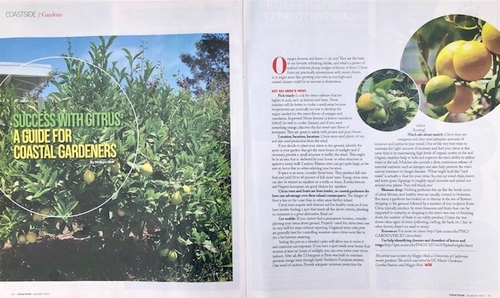Oranges, lemons and limes—oh, my! They are the basis of our favorite refreshing drinks and what's a platter of seafood without plump wedges of lemon or lime? Citrus fruits are practically synonymous with sunny climes so it might seem like growing your own in our fogbound coastal climate could be an exercise in frustration. Not so! Here's how:
Pick wisely:
Look for citrus cultivars that are higher in acid, such as lemons and limes. These varieties will do better in cooler coastal areas because temperatures are normally too low to develop the sugars needed for the sweet flavors of oranges and mandarins. Improved Meyer Lemons (a lemon-mandarin hybrid) do well in cooler climates and if you want something orange, discover the fun sweet-tart flavor of kumquats. They are great in salads with pecans and goat cheese.
Location, location, location:
Citrus trees need plenty of sun and also need protection from the wind. If you decide to plant your citrus in the ground, identify the spots in your garden that get the most hours of sunlight and if necessary, provide a small structure to buffer the wind. This might be in an area that is sheltered by your house or other structure or against a sunny wall. Caution: mature trees can get quite large so be sure to factor that in when selecting your location.
If space is an issue, consider dwarf trees: they produce full size fruit and yield 50- 60% of full sized trees. Young citrus trees can also be trained as espaliers on a trellis or fence. Eureka lemons and Nagami kumquats are good choices for espaliers.
Citrus trees and fruits are frost tender so coastal gardeners do have one advantage over their inland counterparts: the danger of frost is less on the coast than in other areas farther inland.
Citrus trees require well-drained soil for healthy roots so if you have trouble finding a spot that meets all the above criteria, planting in containers is a great alternative. Read on!
Get mobile:
If you cannot find a permanent location, consider planting your citrus above ground. Properly cared for, citrus trees can do very well for years without repotting. Unglazed terra cotta pots are generally best for controlling moisture since citrus roots like to dry a bit between watering.
Setting the pot on a wheeled caster will allow you to move it and maximize sun exposure. If you have a spot inside your home that receives at least 6 hours of sunlight, you can even move your citrus indoors. After all, the L'Orangerie in Paris was built to maintain precious orange trees through harsh northern European winters. One word of caution: provide adequate moisture protection for indoor flooring!
Much Ado About Mulch
Citrus trees are evergreen so they need adequate amounts of moisture and nutrients year round. One of the very best ways to maintain the right amount of moisture and feed your citrus at the same time is by maintaining high levels of organic matter in the soil. Organic mulches help to hold and improve the tree's ability to utilize water in the soil. Mulches also provide a slow, continuous release of essential nutrients such as nitrogen and also help preserve the tree's natural resistance to fungal diseases. What might look like “yard waste” is actually a feast for your citrus. So mix up wood chips, leaves and some grass clippings in roughly equal amounts and spread out around your plants. They will thank you!
Blossom drop:
Nothing perfumes the air like the heady scent of citrus blooms and healthy trees are usually covered in blossoms. But many a gardener has looked on in dismay at the site of flowers dropping to the ground followed by a number of tiny incipient fruits. Citrus typically produce far more blossoms and fruits than can be supported to maturity so dropping is the tree's own way of thinning down the number of fruits it can viably produce. Unless the tree shows other signs of stress (yellowing, curling, dieback, etc.) due to other factors, there's no need to worry.
Resources:
For more on citrus: http://ipm.ucanr.edu/PMG/GARDEN/FRUIT/citrus.html For help identifying diseases and disorders of leaves and twigs: http://ipm.ucanr.edu/PMG/C107/m107bpleaftwigdis.html
This article was written by Maggie Mah, a University of California Master Gardener. The article was edited by UC Master Gardeners Cynthia Nations and Maggie Mah.
Attached Images:
